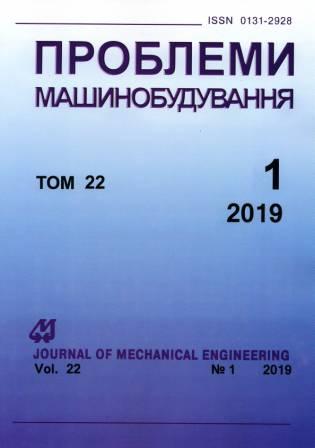Гвинтовий тип симетрії в деталях машин та дизайні при реалізації на 3D-принтері
Ключові слова:
теорія R-функцій, 3D-друк, гвинтовий тип симетрії, шнекАнотація
Створення математичних моделей для реалізації 3D-друку становить значний інтерес, що пов'язаний з активним впровадженням 3D-друку в різні галузі промисловості. Переваги застосування 3D-друку: виготовлення нестандартних моделей, скорочення часу на створення нових прототипів, простота і значна дешевизна виробництва, використання сучасних надміцних матеріалів. Виготовлення деталей машин з гвинтовим типом симетрії відбувається різними, часто дуже складними способами. Це литво з подальшою токарною обробкою, способи гарячої деформації, електрофізичні та електрохімічні способи тощо. Дуже перспективним може виявитися їх виготовлення на 3D-принтері. У цій роботі застосовується теорія R-функцій для математичного та комп'ютерного моделювання геометричних об'єктів з гвинтовим типом симетрії під час реалізації технології 3D-друку. Аналітичний запис проектованих об'єктів дає можливість використовувати буквені геометричні параметри, складні суперпозиції функцій, що, в свою чергу, дозволяє оперативно змінювати їхні конструктивні елементи. Робочої деталлю багатьох механізмів для просування матеріалу уздовж гвинтової поверхні, яка обертається, є шнек. Шнеки використовуються замість коліс в деяких видах всюдиходів або комбайнів. Вони є незамінною деталлю в екструдерах і на бурових станціях. На великих підприємствах їх використовують як засіб транспортування сипучих речовин. Шнеки незамінні в харчовій промисловості. Крім іншого, вони використовуються в стрілецькій зброї, де деталь виконує роль магазина для патронів. В роботі побудовано математичні і комп'ютерні моделі шнеків зі змінним і постійним кроком закрутки, реалізовані на 3D-принтері. В енергетичних установках та інших технічних пристроях широко використовується закрутка потоку для організації та інтенсифікації різних процесів. Закручування є ефективним засобом стабілізації полум'я в камерах згоряння газотурбінних двигунів; використовується для інтенсифікації тепло- і масообміну в каналах; в хімічній, нафтовій, газовій та інших галузях промисловості. Побудовано математичні і комп'ютерні моделі шнекового завихрювача, труби з локальної закруткою, скрученої труби складного поперечного перерізу, які реалізовані на 3D-принтері. Також було здійснено процес побудови настільної лампи з дизай-нерським оформленням у вигляді скручених торів еліптичного перерізу.Посилання
Khalatov, A. A., Avramenko, A. A., & Shevchuk, I.V. (2000). Teploobmen i gidrodinamika v polyakh tsentrobezhnykh massovykh sil [Heat transfer and hydrodynamics in the fields of centrifugal mass forces (Vol. 1–4): Swirl flows (Vol. 3)]. Kiyev:Institute ofEngineering Thermophysics of NASU, 476 p. (in Russian).
Rvachev, V. L. (1982). Teoriya R-funktsiy i nekotoryye yeye prilozheniya [The R-functions theory and some of its applications]. Kiyev: Naukova dumka, 552 p. (in Russian).
Rvachev, V. L. & Sheiko, T. I. (1995). R-functions in boundary value problems in mechanics. Appl. Mech. Reviews, vol. 48, no. 4, pp. 151–188. https://doi.org/10.1115/1.3005099
Maksimenko-Sheyko, K. V. (2009). R-funktsii v matematicheskom modelirovanii geometricheskikh obyektov i fizicheskikh poley [R-functions in mathematical modeling of geometric objects and physical fields].Kharkov: IPMashNAN Ukrainy, 306 p. (in Russian).
Litvinova, Yu. S., Maksimenko-Sheyko, K. V., Sheyko, T. I., & Tolok, A.V. (2016). Analiticheskaya identifikatsiya mashinostroitelnykh detaley s pomoshchyu R-funktsiy [Analytical identification of machine-building parts using R-functions]. Informatsionnyye tekhnologii v proyektirovanii i proizvodstve − Information Technologies in Design and Production, no. 1 (161), pp. 38–44 (in Russian).
Lisin, D. A., Maksimenko-Sheyko, K. V., Tolok, A. V., & Sheyko, T. I. (2011). R-funktsii v kompyuternom modelirovanii dizayna 3D-poverkhnosti avtomobilya [R-functions in computer simulation of the design of the 3D surface of a car]. Prikladnaya informatika − Journal of Applied Informatics, no. 6 (36), pp. 78−85 (in Russian).
##submission.downloads##
Опубліковано
Номер
Розділ
Ліцензія
Авторське право (c) 2019 T. I. Sheyko, K. V. Maksymenko-Sheiko, A. I. Morozova

Ця робота ліцензується відповідно до Creative Commons Attribution-NoDerivatives 4.0 International License.
Автори, які публікуються в цьому журналі, погоджуються з наступними умовами:
- Автори залишають за собою право на авторство своєї роботи і передають журналу право першої публікації цієї роботи на умовах ліцензійного договору (угоди).
- Автори мають право самостійно укладати додаткові договори (угоди) з неексклюзивного поширення роботи в тому вигляді, в якому вона була опублікована цим журналом (наприклад, розміщувати роботу в електронному сховищі установи або публікувати в складі монографії), за умови збереження посилання на першу публікацію роботи в цьому журналі.
- Політика журналу дозволяє розміщення авторами в мережі Інтернет (наприклад, у сховищах установи або на персональних веб-сайтах) рукопису роботи як до подачі цього рукопису в редакцію, так і під час її редакційної обробки, оскільки це сприяє виникненню продуктивної наукової дискусії і позитивно позначається на оперативності та динаміці цитування опублікованої роботи (див. The Effect of Open Access).

